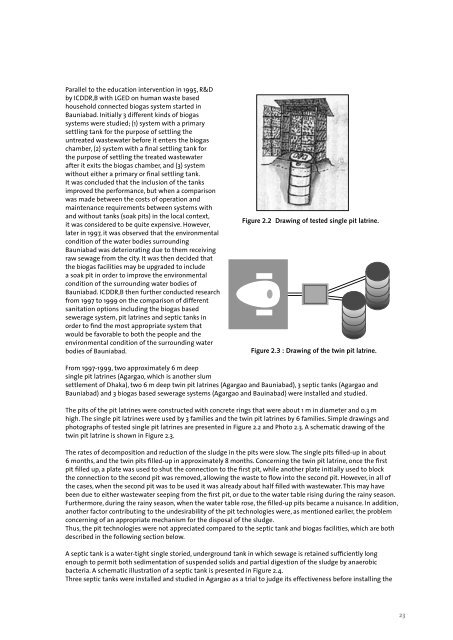Untitled - UNU-IAS - United Nations University
Untitled - UNU-IAS - United Nations University
Untitled - UNU-IAS - United Nations University
You also want an ePaper? Increase the reach of your titles
YUMPU automatically turns print PDFs into web optimized ePapers that Google loves.
Parallel to the education intervention in 1995, R&D<br />
by ICDDR,B with LGED on human waste based<br />
household connected biogas system started in<br />
Bauniabad. Initially 3 different kinds of biogas<br />
<br />
systems were studied; (1) system with a primary<br />
settling tank for the purpose of settling the<br />
untreated wastewater before it enters the biogas<br />
chamber, (2) system with a final settling tank for<br />
<br />
the purpose <br />
of settling the treated wastewater<br />
after it exits <br />
the biogas chamber, and (3) system<br />
without <br />
either a primary or final settling tank.<br />
It was concluded <br />
that the inclusion of the tanks<br />
improved the performance, but when a comparison<br />
was made between the costs of operation and<br />
maintenance requirements between systems with<br />
and without tanks (soak pits) in the local context,<br />
it was considered to be quite expensive. However,<br />
later in 1997, it was observed that the environmental<br />
condition of the water bodies surrounding<br />
Bauniabad was deteriorating due to them receiving<br />
raw sewage from the city. It was then decided that<br />
the biogas facilities may be upgraded to include<br />
a soak pit in order to improve the environmental<br />
condition of the surrounding water bodies of<br />
Bauniabad. ICDDR,B then further conducted research<br />
from 1997 to 1999 on the comparison of different<br />
sanitation options including the biogas based<br />
sewerage system, pit latrines and septic tanks in<br />
order to find the most appropriate system that<br />
would be favorable to both the people and the<br />
environmental condition of the surrounding water<br />
bodies of Bauniabad.<br />
<br />
<br />
<br />
<br />
<br />
From 1997-1999, two approximately 6 m deep<br />
single pit latrines (Agargao, which is another slum<br />
settlement of Dhaka), two 6 m deep twin pit latrines (Agargao and Bauniabad), 3 septic tanks (Agargao and<br />
Bauniabad) and 3 biogas based sewerage systems (Agargao and Bauinabad) were installed and studied.<br />
The pits of the pit latrines were constructed with concrete rings that were about 1 m in diameter and 0.3 m<br />
high. The single pit latrines were used by 3 families and the twin pit latrines by 6 families. Simple drawings and<br />
photographs of tested single pit latrines are presented in Figure 2.2 and Photo 2.3. A schematic drawing of the<br />
twin pit latrine is shown in Figure 2.3.<br />
<br />
<br />
<br />
The rates of decomposition and reduction of the sludge in the pits were slow. The single pits filled-up in about<br />
6 months, and the twin pits filled-up in approximately 8 months. Concerning the twin pit latrine, once the first<br />
pit filled up, a plate was used to shut the connection to the first pit, while another plate initially used to block<br />
the connection to the second pit was removed, allowing the waste to flow into the second pit. However, in all of<br />
the cases, when the second pit was to be used it was already about half filled with wastewater. This may have<br />
been due to either wastewater seeping from the first pit, or due to the water table rising during the rainy season.<br />
Furthermore, during the rainy season, when the water table rose, the filled-up pits became a nuisance. In addition,<br />
another factor contributing to the undesirability of the pit technologies were, as mentioned earlier, the problem<br />
concerning of an appropriate mechanism for the disposal of the sludge.<br />
Thus, the pit technologies were not appreciated compared to the septic tank and biogas facilities, which are both<br />
described in the following section below.<br />
A septic tank is a water-tight single storied, underground tank in which sewage is retained sufficiently long<br />
enough to permit both sedimentation of suspended solids and partial digestion of the sludge by anaerobic<br />
bacteria. A schematic illustration of a septic tank is presented in Figure 2.4.<br />
Three septic tanks were installed and studied in Agargao as a trial to judge its effectiveness before installing the<br />
<br />
<br />
<br />
<br />
<br />
<br />
<br />
<br />
<br />
<br />
<br />
<br />
<br />
<br />
<br />
<br />
Figure 2.2 Drawing of tested single pit latrine.<br />
23
















